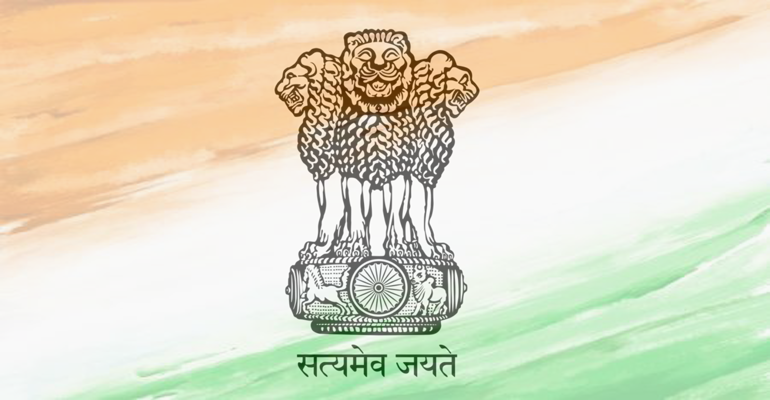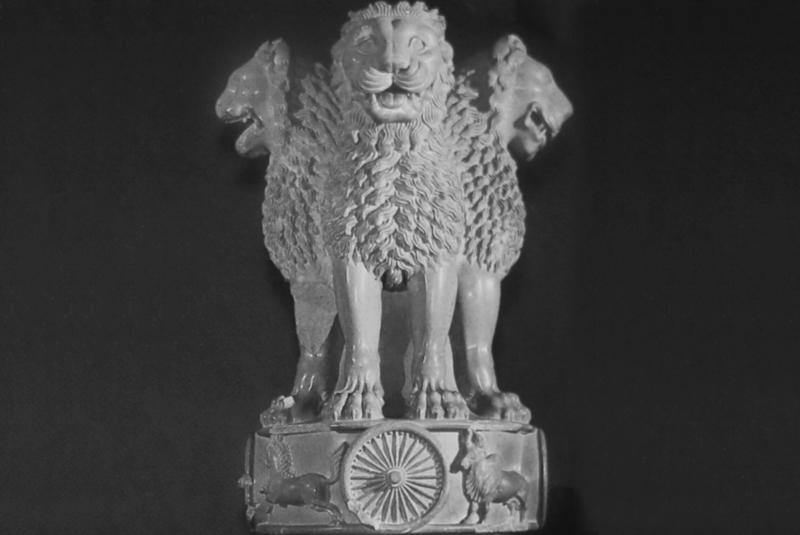The National Emblem of India is a representative seal of the Republic of India derived from the Lion Capital of Ashoka Pillar (in Sarnath, Uttar Pradesh). On January 26, 1950, India chose it as its State Emblem. The Indian National Emblem's slogan is 'Satyamev Jayate' or 'Truth Alone Triumphs.' The National Emblem is a sign of power that appears in all official communications from the government.
An emblem is "a heraldic instrument or symbolic object that serves as a unique insignia of a nation, organization, or family". A nation's National Emblem is a seal designated for official purposes that commands respect and loyalty. For a country, it is a symbol of authority and represents the foundation of its constitutional ideals. Madhav Sawhney accepted the Indian national emblem on January 26, 1950. According to the guidelines, the National Emblem of India can only be used under the State Emblem of India (Prohibition of Improper Use) Act of 2005 and any unlawful use is penalized by law.
Who Wrote Satyamev Jayate?
Satyamev Jayate was written by Pandit Madan Mohan Malviya. He gave the slogan in his presidential address at the Indian National Congress convention in 1918. The slogan was derived from his poem in the novel Anandmath (1882).

Satyameva Jayate Meaning in Hindi and English

'Satyameva Jayate' is an aphorism or great statement which appears on India's national emblem. The insignia features a four-faced lion resting on a full-blossomed lotus. Just below this, in Devanagari script, the Sanskrit word 'Satyameva Jayate' appears as the national motto, which means 'Truth alone Triumphs'.
This lion symbol is based on the famed Ashokan lion of Sarnath, in the holy city of Varanasi in Uttar Pradesh, which Emperor Ashoka constructed in the third century BC at the site where the Buddha first preached his profound doctrine of peace and freedom to all four directions of the world.
The motto is the first line of a four-line mantra (Mantra 3.1.6 of the Mundaka Upanishad):
सत्यमेव जयते नानृतं
सत्येन पन्ता विततो देवयान:।
योनाक्रमन्त्य ऋश्षयो ह्याप्तकामा
यत्र तथ सत्यस्या परमं निधानम्।।
(satyameva jayate nānṛtaṃ | satyena panthā vitato devayānaḥ yenākramantyṛṣayo hyāptakāmā | yatra tat satyasyaa paramaṃ nidhānamm)
Satyameva Jayate Meaning in Hindi
The meaning of this profound saying in Hindi is “सत्य की ही जीत होती है”.
Satyameva Jayate Meaning in English
Translated in English, the slogan means: "The truth alone triumphs, not falsehood. Through truth, the divine path is spread out by which the sages whose desires have been completely fulfilled reach the source of ultimate truth."
History of the National Emblem of India
We now know the true origin of "Satyameva Jayate," but how did it become part of the Indian National Emblem? While presiding over the Congress Session in 1918, Pandit Madan Mohan Malaviya decided that this line from the Mundaka Upanishad should be the motto for India's freedom. Later, in July 1947, Pandit Nehru proposed a motion to adopt Ashoka's Lion Capital with "Satyameva Jayate" as India's national emblem, which was approved in December 1947.
On January 26, 1950, the day the country was declared a republic, the Indian government selected the first sentence, in its original form, as its uniting theme and official slogan. India's national emblem dates back to the Mauryan times. Emperor Ashoka, a formidable king of the Mauryan dynasty, disseminated Buddhist teachings via sculpture and inscriptions. One of the most notable creations was Ashoka's Lion Capital at Sarnath. In 1905, Friedrich Oscar Oertel discovered this pillar in three sections during a mining expedition. The upper part, featuring the lion sculpture, is currently housed in the Sarnath Museum.
Dinanath Bhargava was charged with designing the National Emblem during the Constitution's drafting. The three lions on the national symbol represent strength, courage, and confidence. Badruddin and Surayya Tyabji suggested using the Lion Capital as the emblem. The State Emblem of India Act of 2005 controls its use. The insignia originally featured four lions, but one was left out during the Constitution's formulation. The four lions on the State Emblem symbolize confidence, authority, courage, and power.
Various animals on the pillar represent parts of the Buddha's teachings. The pillar was carved with stones from Chunar and Mathura. Each pillar weighs around 50 tons and is 40 to 50 feet tall.
There are just six pillars with inscriptions left, together with animal capitals and nineteen additional pillars. The pillar has the Mundaka Upanishad's motto "Satyamev Jayate".
It is used by the President, the Central and State Governments, Indian money and passports, as well as by Indian Police Service Officers and Members of Parliament. Violations of the symbol's usage may result in up to 2 years in jail, a 2,000 rupees fine, or both.

Meaning of the National Emblem of India
- Sovereignty: The emblem symbolizes India's sovereignty, unity, and integrity. The four lions facing four directions are a striking representation of the country's might and greatness.
- Buddhism: Emperor Ashoka built the first Lion Capital of Ashoka at Sarnath, which had a wheel at the bottom. The wheel reflected Buddha's teachings and was a symbol of dharma. As a result, the symbol has been connected with Buddhism, one of India's major faiths.
- Power and Courage: The four lions atop the abacus represent strength, bravery, and confidence. They embody the characteristics required for every nation to survive and succeed and the legacy of those martyrs, like Subhash Chandra Bose, Bhagat Singh and Ramprasad Bismil who gave up everything to see their motherland liberated.
- National Identity and Pride: The emblem is a significant symbol of India's national identity and pride. It appears on Indian banknotes, government letterheads, and other official documents, indicating that India is a sovereign country with a distinct identity.
- History and Culture: The Lion Capital of Ashoka represents India's rich historical and cultural legacy. It has been a component of Indian art and architecture for over two millennia and is a significant emblem of India's past and present.
Usage of the Indian National Emblem
- The national symbol serves as the official seal for the President of India, as well as the federal and state governments.
- It appears on all Indian passports and other foreign papers.
- The logo may be seen on prominent buildings such as Rashtrapati Bhawan, Parliament House, the Supreme Court, and the Central Secretariat.
- It is also exhibited at the entrances to Indian consulates overseas and the homes of Consular Mission Heads.
- The national emblem is displayed at Indian diplomatic missions across the world, as well as by the mission chiefs.
- It may be seen at Raj Bhawans, State Legislatures, High Courts, Secretariat buildings, and other key locations throughout the states and union territories.
What are the animals in Ashoka Chakra?
The emblem depicts four Asiatic lions standing in a back-to-back position, representing strength, bravery, assurance, and belief. These lions are placed on a circular abacus, which in turn is positioned on a lotus. At the center of the abacus lies the wheel of the law, known as Dharmachakra.
Satyameva Jayate and Madan Mohan Malviya
Pandit Madan Mohan Malaviya also left a legacy with the motto Satyameva Jayate. Presiding over the Indian National Congress assembly in Delhi in 1918, he stated that this line from the Mundaka Upanishad should be the nation's slogan.
Malaviya was an Indian scholar, educational reformer, and politician known for his contributions to the Indian independence struggle. He served as president of the Indian National Congress twice and founded the Akhil Bharat Hindu Mahasabha. He was called both Pandit, a term of honor, and Mahamana (Great Soul).
Malaviya established the ritual of Aarti at Har ki Pauri Haridwar to the sacred Ganga river, which is still performed today. Malaviya Dwipa, a tiny island across the ghat, is named after him, and a bust of him is constructed there. The Indian Post published stamps in his honor in 1961 and 2011 to commemorate his 100th and 150th birthdays, respectively.
Malaviya worked to promote modern education among Indians, co-founding the Banaras Hindu University (BHU) in Varanasi in 1916, which was established under the 1915 BHU Act. It is Asia's biggest residential university and one of the world's largest, with over 40,000 students studying arts, business, sciences, engineering, linguistics, religion, medicine, agriculture, performing arts, law, management, and technology from all over the world. He served as vice chancellor of Banaras Hindu University from 1919 until 1938.
Malaviya became President of the Indian National Congress in 1909, a post he held again in 1918. He was a moderate politician who opposed separate electorates for Muslims under the Lucknow Pact of 1916. Mahatma Gandhi conferred the title "Mahamana" on him. He is also known for his involvement in abolishing the Indian indenture system, particularly in the Caribbean. His attempts to help Indo-Caribbeans are comparable to Mahatma Gandhi's efforts to assist Indians in South Africa.

Significance of the National Motto of India
One might suppose that "Satyameva Jayate" is all about telling the truth. If that's the case, another passage in the Rig Veda states "Ekam Sat Viprah Bahuda Vadanti," which translates as "Truth is one, but the wise speak of it in many ways." So what is the reality about "Satyameva Jayate"? Taken out of context, one may think that "Satyameva Jayate" is about telling the truth. However, when we look at the original poem's context, we can see that the phrase suggests that an individual may live a happy life by being honest with themselves and embracing their reality. This allows one to fulfill their aspirations and eventually brings them to the source of ultimate truth, which is God.
Undoubtedly, corruption is a major national weakness. From the four-walled police station to the vibrant school classes, it surrounds us in unnoticed ways. The truth may never prevail unless corruption is addressed. Even when the situation seems hopeless, stories of altruistic and truthful individuals inspire millions and enhance our conviction in truth. Hopefully, these few but powerful personalities will inspire more of our youth than society's fake heroes and truth will triumph.















